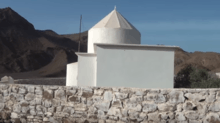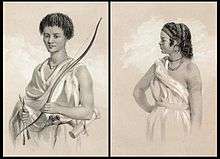Issa (clan)
|
| |
 The Tomb of Sheikh Issa | |
| Regions with significant populations | |
|---|---|
| Languages | |
| Somali, Arabic and French | |
| Religion | |
| Islam | |
| Related ethnic groups | |
| Gadabuursi, other Dir groups and Somali clans |
The Issa or Eesah or Aysa(Somali: Ciise, Reer Sheikh Ciise, Arabic: عيسى) are a Somali clan, and a sub-clan of the Dir.[1] Members primarily reside in Djibouti, Awdal in the self-declared Republic of Somaliland, as well as the Shinile Zone located in the Somali Region of Ethiopia and is one of the largest clans of the Dir. Traditionally, they live as nomadic cattle breeders, but they also engage in trade and have contacts throughout the region. The populations of Six major cities of Djibouti: Djibouti City, Ali Sabieh, Arta, Dikhil, Holhol, Ali Adde and Assamo – are predominantly Issa and in Ethiopia: Dire Dawa, Ayesha, Adigale, Erer and Āfdem and Somalia: Zeila and Xariirad.
History
According to early Islamic books and Somali tradition, the Issa clan was founded in the 14th or 13th century, He settled between Rugay and Maydh in modern-day northernwestern Somalia. The Issa are origins descended of Irir, son of Samaale eponymous ancestor to Arabian Banu Hashim origins through Aqiil Abu Talib ibn Abd al-Muttalib. The Issa were supporters of Imam Ahmad ibn Ibrahim al-Ghazi during his 16th century conquest of Abyssinia, who fought at Antukyah, among other battles. The Issa branch of the Somali represent the largest ethnic group in Djibouti and make up roughly one half of the country's total population. The Issa clan has produced numerous noble Somali men and women over the centuries. In 1884, the territory was occupied by France and given the name "French Somaliland." Mahamoud Harbi was an important spokesman for the independence movement. 1977 continued the Issa of Djibouti's independence through, but not the union with Somalia. Under Hassan Gouled Aptidon to Djibouti became the party state of the People's Rally for Progress (RPP). It was not until 1977 that independence was regained. The Issa in particular, is the only clan with a longstanding tradition of sultan. The Issa use the title "Ugaas" which means sultan and/or king. He has been crowned Zeilan in the northern Somalia. The king does not have a permanent Celestial Court, but he will travel to the clan in Ethiopia and Djibouti. In the Italian invasion of Ethiopia in 1935/36 Issa fought on the Italian side, and benefited in return of weapons, military training and lucrative marketing opportunities for their cattle. In the second half of the 20th Century gave Somalia more weapons to Issa, who see it as part of the Western Somali Liberation Front arming.
Distribution
The Issa primarily live in Ethiopia largely where they reach the Oromia and Afar regions and make a large chunk of the Chartered city of Dire Dawa. They also inhabit Djibouti, were they make up half of the population, thirdly they inhabit northwestern Somalia too.[2]The Issa are the largest clan by population within the Djibouti. Also the Issa is the second largest sub-clan within the borders of the Somali region of Ethiopia based on the Ethiopian population census 2008.
The immediate neighbor to the Issa to the west are the Afar (or Danakil) with whom the Issa used to frequently fight. I. M. Lewis used to refer to it as "a of an almost constant state of enmity between the 'Ise and the 'Afar" , To their east the 'Ise are in contact with the Somali Gadabursi to whom they feel themselves akin and share same descent and culture. To the South the Gurgura, Hawiye and Oromo.[3]:70[4]
Lineage
The Issa traditionally traces its Arabian connexions through its Dir affiliations to Aqeel ibn Abi Talib. However, by 1962 it had become the practice to regard the clan founder as a sheikh or even saint in much the same way (and no doubt at least partly in response to their claims) as the eponyms of the Darod and Isaaq clans. Although I.M. Lewis knows of no printed hagiologies in honor of the Issa ancestor, by the time of Lewis's writing a number of hymns (or qasiidas) have been composed for him, and there is a shrine in Djibouti City where he is said to have appeared miraculously. His actual grave lies between Rugay and Maydh in northeastern Somalia.[5] Sheikh Issa tomb most likely pre-date the local arrival of Islam, which would mean their construction took place in the 13th century or earlier.
Clan tree

There is no clear agreement on the clan and sub-clan structures and many lineages are omitted. The following listing is taken from the World Bank's Conflict in Somalia: Drivers and Dynamics from 2005 and the United Kingdom's Home Office publication, Somalia Assessment 2001.[6][7]
- Dir
- Gadabuursi (Gadabursi)
- Bimal (Biimaal)
- Issa
Based on the Notes on the social organisation of the 'Ise Somal. The Isse is divided into the following branches.[3]:73
- Issa
- 'Ali (Walāldōn)
- Hōlle (Fūrlabe)
- Hōrrōne
- 'Ēlēye
- Ūrweyne
- Wardīq
In the south central part of Somalia the World Bank shows the following clan tree:[8]
- Dir
- Isaac
- Garhajis
- Habar Je'lo
- Habar Awal
- Habar Tol
- Gadabursi
- Isse
- Biyomal
- Gadsan
- Qubeys
- Isaac
Prominent figures
- Mahmoud Harbi, Vice-President of the Government Council of French Somaliland.
- Hassan Gouled Aptidon 1916-2006, first President of Djibouti from 1977 to 1999.
- Ismaïl Omar Guelleh, President of Djibouti as of 1999
- Daher Ahmed Farah, Djiboutian politician
- Abdourahman Waberi, novelist.
- Mumin Gala, Djiboutian athlete
- Aden Robleh Awaleh, president of the National Democratic Party.
- Roble Olhaye, permanent representative to the United Nations for the Republic of Djibouti.
- Yacin Elmi Bouh, Djiboutian politician.
- Hussein Ahmed Salah, Djiboutian marathon runner.
Notes
- ↑ King, Preston (1987). An African Winter. Puffin. ISBN 0-14-052365-0., p.169.
- ↑ Olson, James S. (1996). THE PEOPLE OF AFRICA: An Ethnohistorical Dictionary. London: GREENWOOD PRESS. p. 244. ISBN 0-313-27918-7.
- 1 2 Lewis, I.M. (1961). "Notes on the Social Organisation of the ʿĪse Somali". Rassegna di Studi Etiopici. Istituto per l'Oriente C. A. Nallino. 17: 69–82. JSTOR 41299496.
- ↑ Tesfaye, Aaron (2002). Political Power and Ethnic Federalism: The Struggle for Democracy in Ethiopia. Lanham, Maryland: University Press of America Inc. p. 135. ISBN 0-7618-2238-0.
- ↑ Lewis, "Historical Aspects of Genealogies in Northern Somali Social Structure", Journal of African History, 3 (1962), p. 46
- ↑ Worldbank, Conflict in Somalia: Drivers and Dynamics, January 2005, Appendix 2, Lineage Charts, p.55 Figure A-1
- ↑ Country Information and Policy Unit, Home Office, Great Britain, Somalia Assessment 2001, Annex B: Somali Clan Structure, p. 43
- ↑ Worldbank, Conflict in Somalia: Drivers and Dynamics, January 2005, Appendix 2, Lineage Charts, p.56 Figure A-2
References
- King, Preston (1987). An African Winter. Puffin. ISBN 0-14-052365-0.